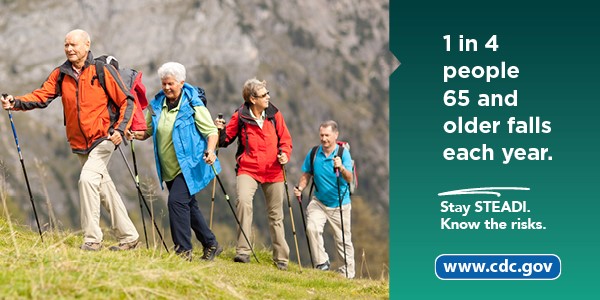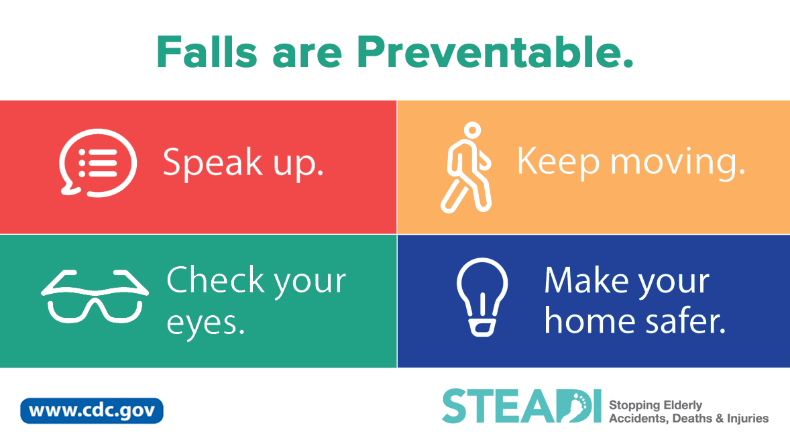Fall Accidents & Prevention
A collection of resources regarding fall accidents, statistics and prevention gathered from specialists all over the world.
The fall problem
Falls take the lives of 684 000 people each year. Beyond the death toll, 172 million more people experience disabilities arising from a fall each year. Falls are not only a significant global public health problem – they are a rapidly growing one. Fall-related deaths have risen far faster than any other type of injury over the last two decades (WHO).
Falls are the leading cause of injury-related death among adults age 65 and older, and the age-adjusted fall death rate is increasing.
Some reasons why people fall
- Previous falls and fear of falling
- Reduced balance and/or muscle strength
- Various neurological diseases such as Parkinson’s disease and after a stroke
- Dementia, confusion and impaired cognition
- Impaired nutritional intake
- Visual impairment
- Medicines that affect, for example, attention, sleep and blood pressure
- Factors in the physical environment such as poor lighting, slippery or uneven floors, lack of or misplaced handrails, slippery or inappropriate footwear, and inappropriately placed carpets and furniture.
World Health Organization – Falls Read More
Centers for Disease Control and Prevention – Facts About Falls Read More
Centers for Disease Control and Prevention – Hip Fractures Among Older Adults Read More
NHS – Falls and Prevention Read More
Cambridge University – The Psychology of Fall Risk: Fear, Anxiety, Depression, and Balance Confidence Read more
Clinical Rehabilitation – The emotional consequences of falls for older people and their families Read more
Bournemouth University – Accidental Falls and Psychological Trauma in Older People Read more
Aging Clinical and Experimental Research Journal – Both psychological factors and physical performance are associated with fall-related concerns Read more
Gait & Posture – How fear of falling can increase fall-risk in older adults: Applying psychological theory to practical observations Read more
Aging & Mental Health – Qualitative study on the impact of falling in frail older persons and family caregivers: Foundations for an intervention to prevent falls Read more
Centers for Disease Control and Prevention – Older Adult Falls: A Growing Danger Read More
Centers for Disease Control and Prevention – Keep on your feet – Preventing Older Adult Falls Read More
Falls using mobility aids
Even though a mobility device is designed to help people stay active and remain independent, many people fall using their walker. Studies show that people are more afraid of falling again if the previous fall was with a mobility aid than without.
It is estimated that up to 3% of users fall at least once a year using their rollator walker.
Swedish Handicap Institute – The Importance of the 4-Wheeled Walker for Elderly Woman Living in their Home Environment Read More
Chalmers Industrial Technology – Rollator related pedestrian single accidents and collision events in Sweden Read More
Department of Internal Medicine, Section of Geriatric Medicine, Erasmus MC, University Medical Center Rotterdam, , Rotterdam, The Netherlands – Four-wheeled walker related injuries in older adults in the Netherlands Read More
CareGivers America – Q and A: Falling Riske, Even With A Walker Read More
The Wright Stuff – Walkers Can Cause Injuries Read More
ECRC Physical Therapy – 3 Ways To Prevent Falls With Your Walker Read More
Help Me Devices – The Biggest Mistakes Seniors Make When Using A Rollator Walker Read More
VeryWell Health – Elderly Falls Tied to Canes And Walkers Read More
Best practises on preventing falls from the publications listed on this page
♦ Talk to your doctor about fall risks and prevention.
♦ Stay active as much as possible and do excersises to improve strength and balance.
♦ Make your home safer by removing obstacles, use non-slip mats in the bathroom, and add grab bars. Ensure all rooms, staircases and passages are well lit.
♦ Walk carefully and avoid walking on uneven surfaces and use walking aids when necessary.
♦ Look after your sight and have eye tests once a year.
♦ Check your feet and use proper footwear.


